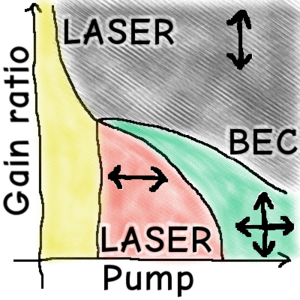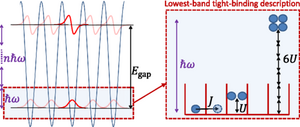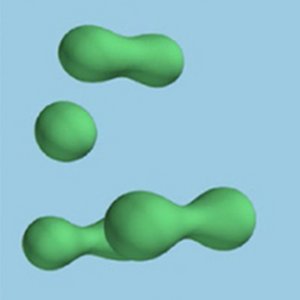Highlights
Publication Highlights
Pump-Power-Driven Mode Switching in a Microcavity Device and Its Relation to Bose-Einstein Condensation
H.A.M. Leymann et al., Phys. Rev. X 7, 021045 (2017)
We investigate the switching of the coherent emission mode of a bimodal microcavity device, occurring when the pump power is varied. We compare experimental data to theoretical results and identify the underlying mechanism based on the competition between the effective gain, on the one hand, and the intermode kinetics, on the other. When the pumping is ramped up, above a threshold, the mode with the largest effective gain starts to emit coherent light, corresponding to lasing. In contrast, in the limit of strong pumping, it is the intermode kinetics that determines which mode acquires a large occupation and shows coherent emission. We point out that this latter mechanism is akin to the equilibrium Bose-Einstein condensation of massive bosons. Thus, the mode switching in our microcavity device can be viewed as a minimal instance of Bose-Einstein condensation of photons. Moreover, we show that the switching from one cavity mode to the other always occurs via an intermediate phase where both modes are emitting coherent light and that it is associated with both superthermal intensity fluctuations and strong anticorrelations between both modes.
weiterlesenWe investigate the switching of the coherent emission mode of a bimodal microcavity device, occurring when the pump power is varied. We compare experimental data to theoretical results and identify the underlying mechanism based on the competition between the effective gain, on the one hand, and the intermode kinetics, on the other. When the pumping is ramped up, above a threshold, the mode with the largest effective gain starts to emit coherent light, corresponding to lasing. In contrast, in the limit of strong pumping, it is the intermode kinetics that determines which mode acquires a large occupation and shows coherent emission. We point out that this latter mechanism is akin to the equilibrium Bose-Einstein condensation of massive bosons. Thus, the mode switching in our microcavity device can be viewed as a minimal instance of Bose-Einstein condensation of photons. Moreover, we show that the switching from one cavity mode to the other always occurs via an intermediate phase where both modes are emitting coherent light and that it is associated with both superthermal intensity fluctuations and strong anticorrelations between both modes.
Publication Highlights
Neutron scattering in the proximate quantum spin liquid a-RuCl3
Arnab Banerjee et al. Science 356, 1055 (2017)
The Kitaev quantum spin liquid (KQSL) is an exotic emergent state of matter exhibiting Majorana fermion and gauge flux excitations. The magnetic insulator ?-RuCl3 is thought to realize a proximate KQSL. We used neutron scattering on single crystals of ?-RuCl3 to reconstruct dynamical correlations in energy-momentum space. We discovered highly unusual signals, including a column of scattering over a large energy interval around the Brillouin zone center, which is very stable with temperature. This finding is consistent with scattering from the Majorana excitations of a KQSL. Other, more delicate experimental features can be transparently associated with perturbations to an ideal model. Our results encourage further study of this prototypical material and may open a window into investigating emergent magnetic Majorana fermions in correlated materials.
See also: A. Banerjee et al. Nature Materials, 15, 733 (2016).
weiterlesenThe Kitaev quantum spin liquid (KQSL) is an exotic emergent state of matter exhibiting Majorana fermion and gauge flux excitations. The magnetic insulator ?-RuCl3 is thought to realize a proximate KQSL. We used neutron scattering on single crystals of ?-RuCl3 to reconstruct dynamical correlations in energy-momentum space. We discovered highly unusual signals, including a column of scattering over a large energy interval around the Brillouin zone center, which is very stable with temperature. This finding is consistent with scattering from the Majorana excitations of a KQSL. Other, more delicate experimental features can be transparently associated with perturbations to an ideal model. Our results encourage further study of this prototypical material and may open a window into investigating emergent magnetic Majorana fermions in correlated materials.
See also: A. Banerjee et al. Nature Materials, 15, 733 (2016).
Publication Highlights
Equilibration and Order in Quantum Floquet Matter
R. Moessner and S. L. Sondhi, Nature Physics 13, 424 (2017)
Equilibrium thermodynamics is characterized by two fundamental ideas: thermalization—that systems approach a late time thermal state; and phase structure—that thermal states exhibit singular changes as various parameters characterizing the system are changed. We summarize recent progress that has established generalizations of these ideas to periodically driven, or Floquet, closed quantum systems. This has resulted in the discovery of entirely new phases which exist only out of equilibrium, such as the ?-spin glass/Floquet time crystal.
This is a progress article. For related original work see: Phase Structure of Driven Quantum Systems, Khemani et al. Phys. Rev. Lett. 116, 250401 (2016).
weiterlesenEquilibrium thermodynamics is characterized by two fundamental ideas: thermalization—that systems approach a late time thermal state; and phase structure—that thermal states exhibit singular changes as various parameters characterizing the system are changed. We summarize recent progress that has established generalizations of these ideas to periodically driven, or Floquet, closed quantum systems. This has resulted in the discovery of entirely new phases which exist only out of equilibrium, such as the ?-spin glass/Floquet time crystal.
This is a progress article. For related original work see: Phase Structure of Driven Quantum Systems, Khemani et al. Phys. Rev. Lett. 116, 250401 (2016).
Publication Highlights
Competition between histone and transcription factor binding regulates the onset of transcription in zebrafish embryos
Shai R Joseph et al. eLife 2017;6:e23326
Upon fertilization, the genome of animal embryos remains transcriptionally inactive until the maternal-to-zygotic transition. At this time, the embryo takes control of its development and transcription begins. How the onset of zygotic transcription is regulated remains unclear. Here, we show that a dynamic competition for DNA binding between nucleosome-forming histones and transcription factors regulates zebrafish genome activation. Taking a quantitative approach, we found that the concentration of non-DNA-bound core histones sets the time for the onset of transcription. The reduction in nuclear histone concentration that coincides with genome activation does not affect nucleosome density on DNA, but allows transcription factors to compete successfully for DNA binding. In agreement with this, transcription factor binding is sensitive to histone levels and the concentration of transcription factors also affects the time of transcription. Our results demonstrate that the relative levels of histones and transcription factors regulate the onset of transcription in the embryo.
weiterlesenUpon fertilization, the genome of animal embryos remains transcriptionally inactive until the maternal-to-zygotic transition. At this time, the embryo takes control of its development and transcription begins. How the onset of zygotic transcription is regulated remains unclear. Here, we show that a dynamic competition for DNA binding between nucleosome-forming histones and transcription factors regulates zebrafish genome activation. Taking a quantitative approach, we found that the concentration of non-DNA-bound core histones sets the time for the onset of transcription. The reduction in nuclear histone concentration that coincides with genome activation does not affect nucleosome density on DNA, but allows transcription factors to compete successfully for DNA binding. In agreement with this, transcription factor binding is sensitive to histone levels and the concentration of transcription factors also affects the time of transcription. Our results demonstrate that the relative levels of histones and transcription factors regulate the onset of transcription in the embryo.
Publication Highlights
Colloquium: Atomic quantum gases in periodically driven optical lattices
André Eckardt, Rev. Mod. Phys. 89, 011004 (2017)
Time-periodic forcing in the form of coherent radiation is a standard tool for the coherent manipulation of small quantum systems like single atoms. In the last years, periodic driving has more and more also been considered as a means for the coherent control of many-body systems. In particular, experiments with ultracold quantum gases in optical lattices subjected to periodic driving in the lower kilohertz regime have attracted much attention. Milestones include the observation of dynamic localization, the dynamic control of the quantum phase transition between a bosonic superfluid and a Mott insulator, as well as the dynamic creation of strong artificial magnetic fields and topological band structures. This Colloquium reviews these recent experiments and their theoretical description. Moreover, fundamental properties of periodically driven many-body systems are discussed within the framework of Floquet theory, including heating, relaxation dynamics, anomalous topological edge states, and the response to slow parameter variations.
weiterlesenTime-periodic forcing in the form of coherent radiation is a standard tool for the coherent manipulation of small quantum systems like single atoms. In the last years, periodic driving has more and more also been considered as a means for the coherent control of many-body systems. In particular, experiments with ultracold quantum gases in optical lattices subjected to periodic driving in the lower kilohertz regime have attracted much attention. Milestones include the observation of dynamic localization, the dynamic control of the quantum phase transition between a bosonic superfluid and a Mott insulator, as well as the dynamic creation of strong artificial magnetic fields and topological band structures. This Colloquium reviews these recent experiments and their theoretical description. Moreover, fundamental properties of periodically driven many-body systems are discussed within the framework of Floquet theory, including heating, relaxation dynamics, anomalous topological edge states, and the response to slow parameter variations.
Institute's News
New research group 'Strongly Correlated Light-Matter Systems'
We are glad to announce the arrival of Dr. Francesco Piazza, who heads the research group 'Strongly Correlated Light-Matter Systems'. The group will investigate the many-body properties of peculiar quantum “plasmas” of photons and atoms.
weiterlesenPublication Highlights
Growth and Division of Active Droplets Provides a Model for Protocells
D. Zwicker, R. Seyboldt, C. A. Weber, A. A. Hyman and F. Jülicher, Nature Physics (2016)
We show that liquid droplets that are driven away from thermodynamic equilibrium by chemical reactions can undergo cycles of growth and division reminiscent of living cells. We propose such active droplets as simple models for prebiotic protocells. Our work shows that protocells could have been able to propagate and divide without having established membranes.
See also coverage in Chemistry World and two articles in Quanta Magazine: article 1 and article 2.
weiterlesenWe show that liquid droplets that are driven away from thermodynamic equilibrium by chemical reactions can undergo cycles of growth and division reminiscent of living cells. We propose such active droplets as simple models for prebiotic protocells. Our work shows that protocells could have been able to propagate and divide without having established membranes.
See also coverage in Chemistry World and two articles in Quanta Magazine: article 1 and article 2.
Awards and Honors
Verleihung "Physik-Preis Dresden“ des MPI-PKS und der TU Dresden
Am 6. Februar 2017, 16.30 Uhr wird am Max-Planck-Institut für Physik komplexer Systeme (MPI-PKS) erstmalig der „Physik-Preis Dresden“ von der TU Dresden und dem MPI-PKS verliehen. Der diesjährige Preisträger ist Professor Daniel P. Arovas von der University of California, San Diego. Zu diesem Anlass hält Professor Arovas einen Preiskolloquiumsvortrag zum Thema "The Amplitude Mode in Condensed Matter: Higgs Hunting on a Budget".
Professor Arovas hat bahnbrechende Beiträge zur Festkörperphysik geleistet, insbesondere zur Theorie des Magnetismus und der Physik niedrigdimensionaler Systeme.
Nach dem Physikstudium an der Universität Princeton hat Professor Arovas in Santa Barbara an der University of California promoviert, woraufhin er in Chicago Postdoc war. Er war außerdem Visiting Professor in Princeton, Stanford und Haifa.
Der Physik-Preis Dresden, welcher von Professor Peter Fulde, dem Gründungsdirektor des MPI-PKS gestiftet wurde, wird dieses Jahr erstmals vergeben. Der/die Preisträger/in wird von einer gemeinsamen Kommission der TU Dresden und des MPI-PKS bestimmt, wobei neben dem zentralen Kriterium der wissenschaftlichen Exzellenz wichtig ist, dass seine/ihre Arbeiten für die Zusammenarbeit zwischen diesen beiden Institutionen von Bedeutung sind. In diesem Sinne verstärkt dieser Preis deren langjährige Kooperation, welche in letzter Zeit auch institutionell erweitert wurde, z.B. mit der Gründung des Dresden concept e.V. im Rahmen der Exzellenzinitiative.
Professor Arovas hat bestehende Kollaborationen mit Physikern von der TU Dresden, und sein Forschungsfeld hat großen Überlapp mit dem Sonderforschungsbereich „Korrelierter Magnetismus: Von Frustration zu Topologie", an dem Physiker und Chemiker aus der TU sowie mehreren außeruniversitären Forschungsinstituten in Dresden beteiligt sind.
weiterlesenPublication Highlights
U(1) Wilson lattice gauge theories in digital quantum simulators
Christine Muschik, Markus Heyl, et al., arXiv:1612.08653
Lattice gauge theories describe fundamental phenomena in nature, but calculating their real-time dynamics on classical computers appears to be notoriously difficult. Digital quantum simulation has been proposed as a general strategy to solve such computationally hard problems on a programmable quantum device instead of using conventional computers. Recently, an experiment has demonstrated for the first time a digital quantum simulation of a lattice gauge theory on a small-scale quantum computer made of trapped ions. This work has been selected by the magazine Physics World as one of the top ten breakthroughs in physics in 2016. Now, a detailed theoretical analysis of the experimentally used scheme has been published which studies in detail the scheme's performance, robustness against various error sources, and scalability.
See also coverage in Physics World and the experimental work .
weiterlesenLattice gauge theories describe fundamental phenomena in nature, but calculating their real-time dynamics on classical computers appears to be notoriously difficult. Digital quantum simulation has been proposed as a general strategy to solve such computationally hard problems on a programmable quantum device instead of using conventional computers. Recently, an experiment has demonstrated for the first time a digital quantum simulation of a lattice gauge theory on a small-scale quantum computer made of trapped ions. This work has been selected by the magazine Physics World as one of the top ten breakthroughs in physics in 2016. Now, a detailed theoretical analysis of the experimentally used scheme has been published which studies in detail the scheme's performance, robustness against various error sources, and scalability.
See also coverage in Physics World and the experimental work .
Publication Highlights
Superdiffusive Dispersals Impart the Geometry of Underlying Random Walks
V. Zaburdaev, I. Fouxon, S. Denisov, and E. Barkai, Phys. Rev. Lett. 117, 270601
It is recognized now that a variety of real-life phenomena ranging from diffusion of cold atoms to the motion of humans exhibit dispersal faster than normal diffusion. Lévy walks is a model that excelled in describing such superdiffusive behaviors albeit in one dimension. Here we show that, in contrast to standard random walks, the microscopic geometry of planar superdiffusive Lévy walks is imprinted in the asymptotic distribution of the walkers. The geometry of the underlying walk can be inferred from trajectories of the walkers by calculating the analogue of the Pearson coefficient.
weiterlesenIt is recognized now that a variety of real-life phenomena ranging from diffusion of cold atoms to the motion of humans exhibit dispersal faster than normal diffusion. Lévy walks is a model that excelled in describing such superdiffusive behaviors albeit in one dimension. Here we show that, in contrast to standard random walks, the microscopic geometry of planar superdiffusive Lévy walks is imprinted in the asymptotic distribution of the walkers. The geometry of the underlying walk can be inferred from trajectories of the walkers by calculating the analogue of the Pearson coefficient.





